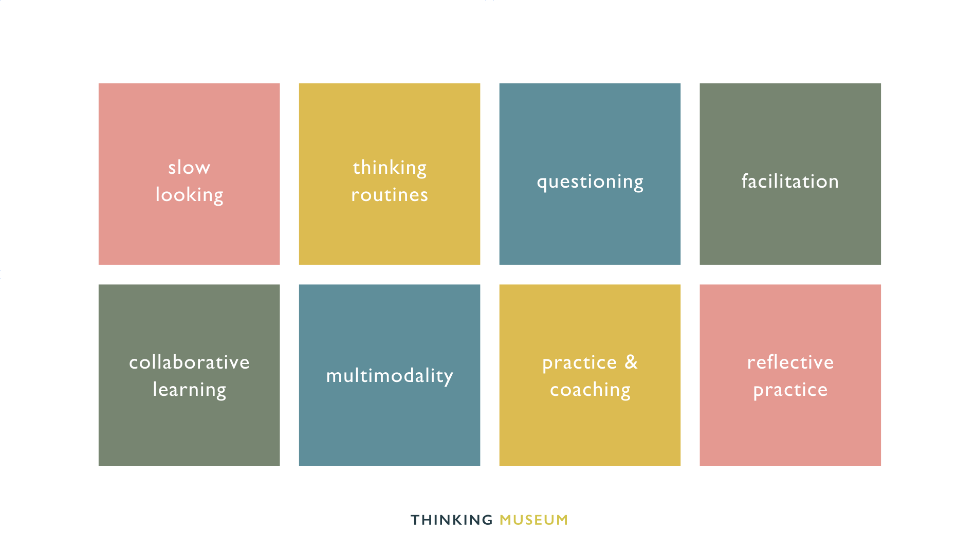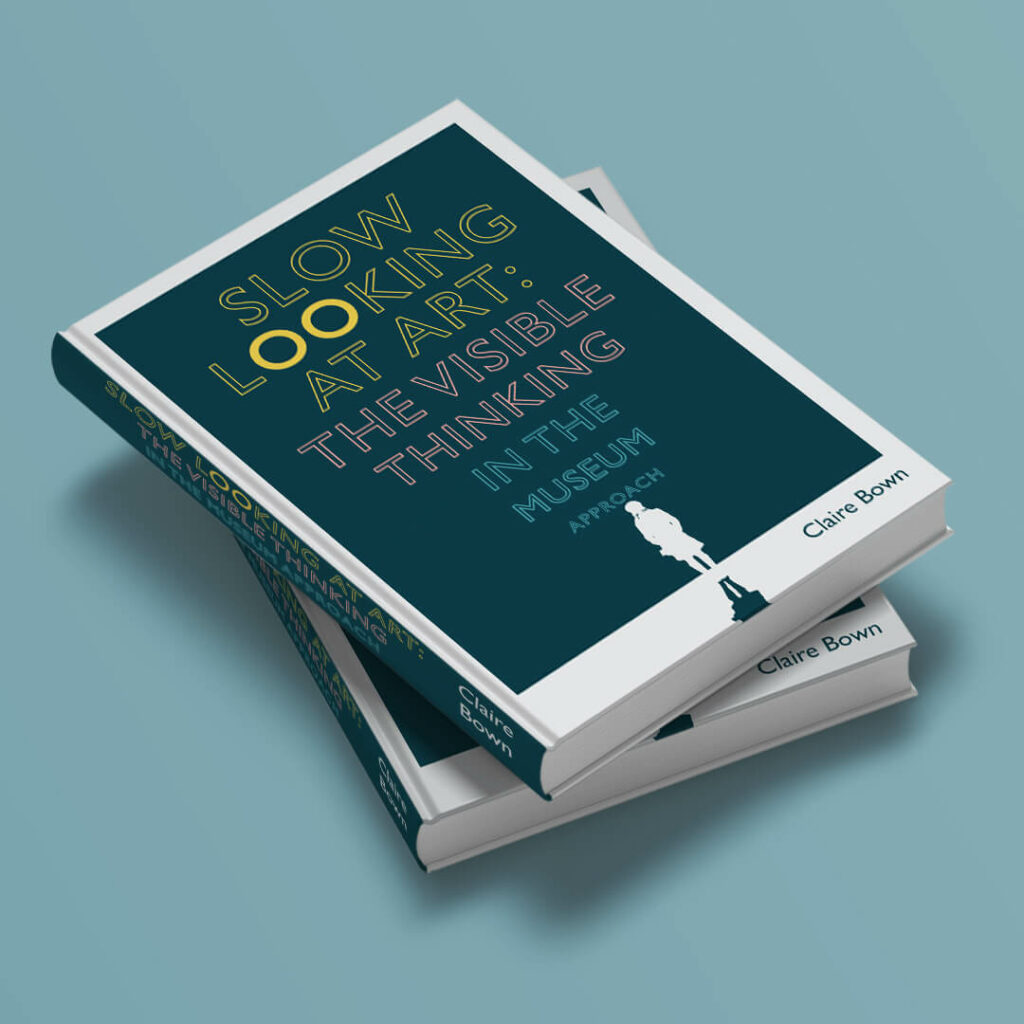
How did the Visible Thinking in the Museum approach come about?
In 2011, I carried out research for my Master’s in Museology at the Tropenmuseum in Amsterdam with with teachers from international schools. My aim was to find out what they wanted from museum visits. I conducted a series of focus groups and spoke to teachers with the goal of designing a new educational programme for primary school students. From the focus groups I facilitated, I found out that teachers were looking for museum programmes that:
- engaged students fully with objects in the museum
- encourage slow looking and careful observation
- fostered group discussion and collaborative learning
- enabled a teaching switch from the ‘sage on the stage’ approach to a ‘guide on the side’
It was during one of these conversations that Melanie Smith, a teacher from the International School of Amsterdam, spoke about Project Zero’s Visible Thinking framework. She suggested that Project Zero thinking routines could have wonderful possibilities within the museum environment (as it had already done within their classrooms).
‘(Project Zero)Thinking routines would work very well in a museum setting as they make you look at things for a very long time. Children are so used to skimming and looking at things quickly. It would be great to have the time to study something. I like the idea of having small groups to work on fewer objects – you would hope that they would come back with their parents or go to any museum and know how to look at objects and teach their parents.’
Melanie Smith, ISA Teacher, Tropenmuseum Focus Group, 2011.
What is Project Zero?
Project Zero is a research initiative based at the Harvard Graduate School of Education that focuses on understanding and enhancing learning, thinking, and creativity in individuals and groups, particularly in educational settings. One of Project Zero’s significant contributions to the field of education is the development of various educational frameworks and approaches – such as Visible Thinking – and thinking routines.
What is Visible Thinking?
Visible Thinking has been developed over a number of years by researchers from Harvard’s Project Zero with teachers and students. Visible Thinking is essentially a ‘broad and flexible framework for enriching learning’ by fostering deep thinking and a better understanding of content.
The central idea of Visible Thinking is simple: making thinking visible.
The vast majority of what we think is hidden – it stays in our heads or ‘under the bonnet’ as David Perkins likes to put it and we only articulate a small portion of it.
The key elements of Visible Thinking are:
- Explaining and articulating thinking out loud
- Listening to others articulating their thinking
- Engaging in discussion whilst forming understanding
Visible Thinking includes a number of key ways of making thinking – and opportunities for thinking – much more visible in classrooms and other learning environments. By making thinking visible to yourself and to those around you, opportunities for learning expand.
What are Project Zero thinking routines?
Thinking routines are tools specifically designed by researchers at Project Zero to help, support and guide mental processes or thinking.
They consist of a short set of questions or series of steps that are used in a regular way. With habitual use, participants are able to automatically cue the steps of the routine themselves.
Thinking routines are designed to serve a specific purpose, and have catchy and appealing names – See Think Wonder; Step Inside – helping you to learn them by heart and put them to good use independently.
Thinking routines can be used to loosely guide the analysis of a wide variety of materials, such as artworks, photographs, documents, newspaper articles, museum objects, and so on.
At the time of writing, Project Zero has developed and documented more than 100 thinking routines and imaginative new thinking routines are being created all the time within Project Zero’s research community. Every year I curate an ‘ultimate’ list of thinking routines and add any new routines that that I discover. Project Zero’s Thinking Routine Toolbox is another great resource for any thinking routine created as part of a PZ research project.
What is Visible Thinking in the Museum?
The ideas and tools within Project Zero’s Visible Thinking framework immediately caught my attention. I wondered if these ideas could hold solutions to the engagement challenges faced by museum educators and teachers.
I recognised the potential for adapting some of these practices for use in the museum environment and combining them with museum education practices, questioning techniques, and other tools and techniques from different fields, such as facilitation and coaching.
Whilst I knew well that Visible Thinking was highly effective in the classroom, I was aware that certain aspects would require adjustments for informal learning settings, such as museums.
This realisation led to the development of the Visible Thinking in the Museum approach (VTM).
The Visible Thinking in the Museum (VTM) approach is grounded in and indebted to the pioneering work and ideas of Project Zero.
VTM takes elements of Project Zero‘s Visible Thinking framework and combines them with museum education practices, facilitation techniques, questioning strategies and coaching tools.
It draws inspiration from these foundations and extends them further into the realm of museum education, combining with my own perspectives.
VTM is a way to engage museum and heritage audiences with what they are looking at, who they’re with and where they are.
The VTM approach fosters meaningful connections: between you and your participants, amongst the participants themselves, and with the artwork or object being explored.
My book is both a tribute to the invaluable work of Project Zero, and a contribution to the further development of these ideas, blended with my own experience, knowledge and insights as a museum educator.
VTM is an easy-to-follow framework that allows museum educators, guides, teachers and docents to confidently design and lead engaging discussion-based sessions with art, objects and ideas with any audience.
Who is Visible Thinking in the Museum for?
Practitioners working within museum/heritage learning and engagement teams and responsible for designing or facilitating tours and programmes for visitors.
VTM can be used by museum educators, museum, heritage and tour guides, volunteers or museum docents, learning practitioners and teachers.
It’s also an approach that can be used by learning practitioners and teachers in all sectors of education who want to incorporate visual art or objects into their teaching.
It’s also been used by creatives and entrepreneurs, freelancers, therapists and mindfulness practitioners.
How does VTM work?
VTM is a flexible structure to explore and discuss a wide variety of materials – in particular museum and heritage collections and their stories. Educators can use thinking routines as the structure to their inquiry-led discussions and to engage their audience with certain skills, such as careful observation, thoughtful interpretation and understanding different viewpoints. The museum teacher, guide or educator facilitates and guides this process combining thinking routines with 8 specific practices.
It puts engagement front and centre.
3 FOUNDATIONS
Engagement is at the heart of VTM. This approach is based around the idea that true engagement with objects involves 3 basic ingredients:
1. SLOW LOOKING: This allows us to see the ‘whole picture’ and helps us to avoid hasty interpretations. Make time for connections to happen.
2. SHARED VISUAL INQUIRY: We reason together out loud, put forward new ideas, respond to and build on the ideas of others & generates further questions.
3. PERSONAL DISCOVERY: Personal discovery is about creating opportunites for participants to make meaningful connections between artworks and objects and their own ideas, interests and perspectives.
These are the foundations upon which my Visible Thinking in the Museum method is built. Any of these three would create engagement on their own, but the magic happens when you put them all together.
8 PRACTICES
There are 8 practices associated with the method
Each of these practices plays a crucial role in the method. It’s the combination of practices that make this such a powerful method. It’s not just a strategy, the VTM approach is a practice, a way of being when you’re with groups in the museum.
Whilst I love Project Zero thinking routines – their structure, flexibility and variety, the way they foster thinking, it takes more than this to create an engaging and memorable discussion around art and objects.
You also need to work on your questioning technique, employ facilitation skills, work multi-modally and encourage a collaborative culture. You need to practice, get coached, and you need to develop a truly reflective practice.
I’ve trained hundreds of educators, guides and creatives to use the VTM approach since 2011. You can work with me as an individual or as a team, either online, in-person or hybrid.
SLOW LOOKING AT ART: THE VISIBLE THINKING IN THE MUSEUM APPROACH
My book Slow Looking at Art: The Visible Thinking in the Museum Approach covers the 3 foundational elements of the method, plus the 8 practices.
You will learn how to give your discussions a flexible structure and substance using Project Zero thinking routines; how to share information as a tool to engage your audience and how best to engage your group with facilitation skills, a sound questioning technique and more. You will learn how to use a variety of thinking routines for group, individual and personal use.
Full of practical steps & helpful advice, this book provides you with everything you need to create engaging discussions with art and objects in the museum.
Slow Looking at Art: The Visible Thinking in the Museum Approach will be published in 2023 as an e-book and a print edition too. Get on the waitlist to be the first to receive a copy.

